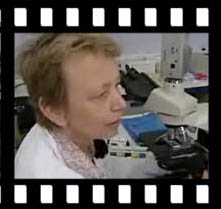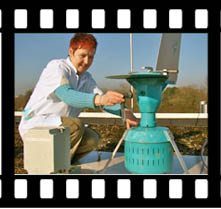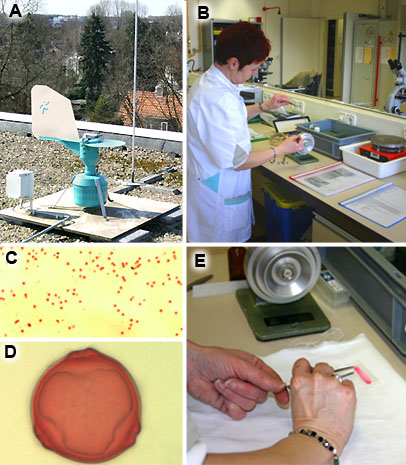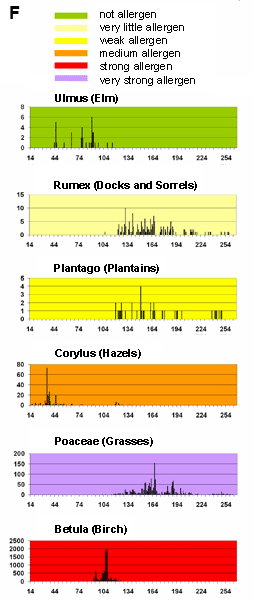Pollen which is dispersed by insects will not, or only rarely and locally, occur in the atmosphere. On the other side, pollen which is propagated by the wind has to be present in a high concentration in the air to have a reasonable chance for succesful pollination.
| Filmpjes over pollenallergie, pollentelling |
 | 
|
| Filmpje van media.vrtnieuws.net uit 2007 in samenwerking tussen het Belgisch Wetenschapelijk Instituut Volksgezondheid en het Universitair Ziekenhuis Gent
| Filmpje over pollenverspreiding, pollentelling en hooikoorts bij hooikoorts.tv © gemaakt bij het pollenteam van het Elkerliek ziekenhuis in Helmond. |
Such plants will thus produce large amounts of airborne pollen, that can then reach our eyes, nose, mouth and throat mucosa. Because these pollen grains are THE source of the major allergic reaction called hay fever, or pollen allergy or pollinosis (more on the
mechanism), it is important to know which pollen is present in the air at a certain time of the year. This feature does not only depend on the flowering period of specific airborne species, but also on the amount of pollen that these plants produce, and on the weather conditions; pollen grains will be rapidly washed out by rain.
In the interest of people suffering of hay fever standardized countings of pollen are performed and published as tables, in the Netherlands and Belgium i.e. by the Elkerliek Hospital in Helmond (see movie about pollen counting in this hospital on the site of pollennieuws.nl) and the LUMC in Leiden, the University Hospital in Gent, the Belgian Scientific Institute for Health and the sites Natuurkalender.
On account of pollen counting, knowledge on allergenicity of pollen species and the weather forecast hay fever prognoses can be made.
In 1989 the "Aerobiology committee" of the EACCI (European Academy of Allergology and Clinical Immunology) and the EAN (European Allergy Network) work group of the IAA (International Association for Aerobiology) have decided to publish European pollen calenders in combination with complementary data. Only calenders made with a Burkard or Lanzoni spore trap over periods of 3 to 5 years are included. In 1999 the first European calenders with the name "The European Pollen Calendar" were published by the EAACI in collaboration with the "European Federation of Asthma and allergy associations" (EFA).
Method for pollen counting
The method forpollen counting has been standardized so that the data can always be compared everywhere. It consists of three steps:
- The collection of pollen grains from the air under controled conditions
- The preparation of microscopic samples
- The recognition, determination and counting of pollen grains in the samples.
1. Pollen collection
In ordertocapture pollen so-called sporeor pollen traps are used. nearly everywhere the Burkard spore trap is prevailed (figure A). It consists of a horizontally free rotating chamber with a single opening that is oriented toward the wind by a wind vane. Above the opening a plate protects the entry from the rain, but also to obtain a regular air flow. Behind the opening a drum covered by a ribbon coated with vaseline. The drum with the ribbon makes a full turn in exactly a given time period of one day or one week. Below the chamber a centrifuge pump gently aspirates a standard volume of air per time unit trhrough the opening of of the chamber along the ribbon on the drum. The pollen grains stick to the ribbon.
2. Microscopical samples
In the laboratory the ribbon is released from the drum (figure B) and it is cut in egual parts. These are then transfered with the vaseline layer face down to a microscopical slide that has been prepared with a gel layer containing the stain safranin (Figure E). Mainly the walls of the pollen grains are stained light red (figure C). Then the strip can be covered with a coverslip for observation wiht a light microscope.
3. Determination and counting of pollen
When the sample is observed in the microscope at low magnification the single pollen grains become visible (figure C). But a high magnification (40x objective or higher) is necessary to distinguish the stained inner and outer wall. Then pollen grains can be identified and counted (figure D). These data can be used to calculate exactly how many pollen grains of which species/family have settled down on the ribbon at a given time point of the week. When compiled in a graph (fugure F) these data give an reliable indication for ther presence of certain pollen grains at a given time in the air. Such a graph is called pollen calendar. With help of a pollen calendar and weather forecast one can establish a
forecast for allergenic pollen in the air. Simplified calendars also give already much information for hay fever patients (figure G).
| Pollen counting and calendars |
 |
 |
 |
A. Burkhard spore trap
This spore trap stays on the roof of the Elkerliek Hospital in Helmond. In the upper part the large wind vane holds the opening below the blue plate directed toward the wind. Below hangs the big centrifuge pump which aspirates a certain volume of air per time unit. The absorbed pollen grains stick on a ribbon that is slowly rotated on a drum.
B. The ribbon of the spore trap
The ribbon is lifted from the drum (in the middle on the table) with the help of forceps and cut into pieces
C. Preparation of a microscopical sample
The piece of ribbon with the pollen grains is laid on a microscopical slide with gel coated with safranin, and then it is covered with a coverslip. The safranin stains the pollen grains light red. All other particles fromthe air remain unstained. Only the cell wall of pollen grain becomes evident.
D. Microscopical observation atlow magnification
In the microscope red pollen grains are already visible at low magnification.
E. Birch pollen, example of microscopical observation at high magnification
At high magnification it is possible to recognize fromwhich plant the pollen grains originate. The pollen grains from the Birch, for example, are round,about 0.02 mm large with three germination pores in their median plane. The germination pores protrude clearly and have a ring (annulus) but no cover (operculum). Below the three germination pores the inner wall shows a strong lenticular thickening.
F. Example of a pollen calendar.
Pollen calendar for the period Januari 14 - September 24 2004. For the species indicated the number of counted pollen grains (vertical Y-axis) a given per day (horizontal x-axis). Not all species are evenly disturbing and not every patient is sensitive in the same way for these species. The color indicates how strongly allergenic a certain species of pollen is in general.
G. Simplified pollen calendar
This simplified pollen calendar shows the approximate flowering time, which thus also corresponds to the pollen release of the most important allergenic species in the Netherlands and Belgium. The colors indicate the peak of the release. |
Webpages and photographs:Jan Derksen and Elisabeth Pierson
Web development: Remco Aalbers







